42. Our Goodman (Child 274)
[The title "Arrow Goodman" appears as version B and several times in the music section (Brown; Volume 4). Since it was not sung nor is part of the text, it appears to be simply a mispronunciation (or just dialect) of the title given to the informant, who did not know the title to be "Our Goodman" in the first place. Woah!!!]
This is one of the few humorous ballads admitted to Child's collection. For its history and its kin in other languages, see Child's headnote; for its range in English since Child's time, see BSM 89-90, and add Virginia (OSC 300-1), North Carolina (FSRA 41), Florida (FSF 317-19), Missouri (OFS I 181-5), Ohio (BSO 82-3), Indiana (BSI 149-50) and Tennessee (BTFLS VIII 72-3). Our North Carolina texts all belong to what BSM calls the first form, in which the wife has but one paramour. The betraying signs come in a different order in the different texts. In fact, A represents one version, B and C another.
A. 'Kind Wife.' Sent by Thomas Smith of Zionville, Watauga county, to C. Alphonso Smith in 1914 and later to the North Carolina collection.
1. 'Kind wife, loving wife, how may it be.
Whose old horse is that where mine ort to be?'
'You old fool, you blamed fool, can't you never see?
It's nothing but a milk cow your mammy sent to me.'
'As long as I can remember— it's forty years or more —
I never saw a milk cow with a saddle on before.'
2. 'Kind wife, loving wife, how may it be,
Whose old hat is that where mine ort to be?'
'You old fool, you blamed fool, can't you never see?
It's nothing but a cabbage head your mammy sent to me.
'As long as I can remember — it's forty years or more —
I never saw a cabbage head with a brim on before.'
3. 'Kind wife, loving wife, how may it be,
Whose old boots are them where mine ort to be?'
'You old fool, you blamed fool, can't you never see?
It's nothing but a milk churn your mammy sent to me.'
'As long as I can remember — it's forty years or more —
I never saw a milk churn with heel irons on before.'
4 'Kind wife, loving wife, how may it be.
Whose old coat is that where mine ort to be?'
'You old fool, you blamed fool, can't you never see?
It's nothing but a counterpane your mammy sent to me.
'As long as I can remember — it's forty years or more —
I never saw a counterpane with coat sleeves on before,'
5 'Kind wife, loving wife, how may it be.
What old man in the bed where I ort to be?'
'You old fool, you blamed fool, can't you never see?
It's nothing but a baby child your mammy sent to me.'
'As long as I can remember — it's forty years or more —
I never saw a baby child with a mustache on before.'
B. 'Arrow Goodman.' Sent in by W. A. Abrams of Boone, Watauga county, in 1937, as "given to me by Chloe Michael, who learned it from her father. He learned it in 1898." Here, as in many other texts recorded, the husband comes home, by his own confession, drunk. The series is reduced to three: boots, horse, head.
1. I came in the other night drunk as I could be.
Somebody's boots in the corner where my boots ought to be.
I says, 'My dear little wifey, come 'splain this thing to me:
Whose boots there in the corner where my boots ought tobe?'
'You drunk fool, you blind fool, you surely cannot see.
It's nothing but a cream jar my granny gave to me.'
'I've traveled this world over ten thousand years or more.
Boot heels on a cream jar I've never seen before.'
2. I came in the other night, drunk as 1 could be.
Somebody's horse in the stable where my horse ought to be.
I says, 'My dear little wifey, come 'splain this thing to me:
Whose horse in the stable where my horse ought to be?'
'You drunk fool, you blind fool, you surely cannot see.
It's nothing but a milk cow my granny gave to me.'
'I've traveled, I've traveled ten thousand miles or more,
A saddle on a milch cow I never have seen before.'
3 I came in the other night, drunk as I could be.
Somebody's head on the pillow where my head ought to be.
I says, 'My dear little wifey, come 'splain this thing to me:
Whose head is on the pillow where my head ought to be?'
'You drunk fool, you blind fool, you surely cannot see.
It's nothing but a cabbagehead my granny gave to me.'
'I've traveled this wide world over ten thousand times or more,
But a cabbage head with a mustache on I never have seen before.'
C. 'Our Goodman.' Sent in by Frank Proffitt of Sugar Grove, Watauga county, in 1937. Essentially the same version as B, but the series runs to four: coat (bed quilt with pockets on it), horse (milk cow with saddle on), head (cabbage with a mustache on), and (by misplacement, apparently) boots (cream pitcher with boots on).
Lucille Cheek of Chatham county reports a single stanza as known among Chatham county Negroes.
-----------------------------------------
42. Our Goodman (Child 274) [Music from Volume 4]
'Kind Wife.' Sung by anonymous singer. Procured by Thomas Smith, Zionville, Watauga county, in 1914. Here, this stanza of twenty-four measures is produced by sheer exploitation of the melodic material of eight measures. This is an excellent example for showing how a melody is adapted to a varying text and just what happens in the process.
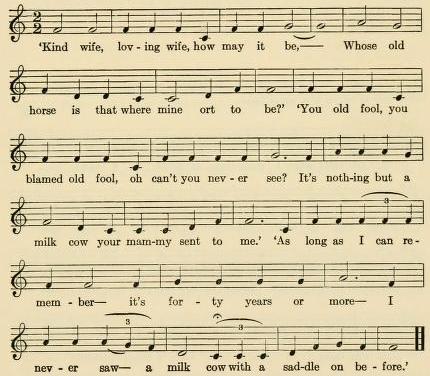
For melodic relationship cf. **SharpK i 270, No. 38E, measures 13-20 which are, more or less, the basic material of our version. Scale : Mode III, plagal. Tonal Center : f. Structure : aba1b1a2b2 (4,4,4,4,4,4) = aa1a2 (8,8,8).
A (1) 'Kind Wife.' Sung by Myra Barnett Miller. Recorded, probably at Lenoir, August 1939, 1940, or 1941. These eight measures are repeated twice to take care of the six lines of the stanza.

For melodic relationship cf. **SharpK, I 270, No. 38E, measures 13-20, which as in the above version, contribute the basic material of this version. Scale: Mode III, plagal. Tonal Center: g. Structure: abed (2,2,2,2). Circular Tune (V).
B. 'Arrow Goodman.' Sung by anonymous singer. No date or place given. Another title given is 'Our Goodman.'
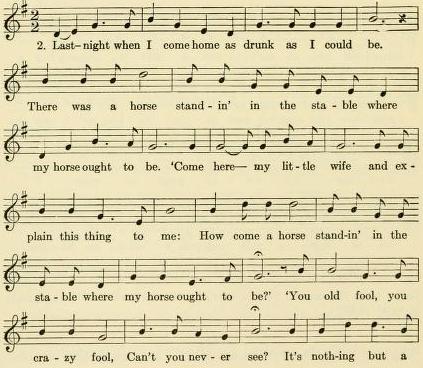
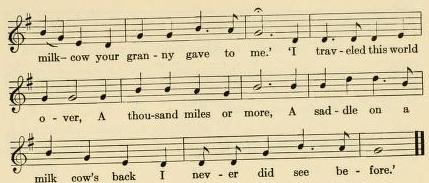
For melodic relationship cf. *SharpK i 270, No. 38E, measures 7-8 and 15-16, wliich are like our 3-4.
Scale: Hexatonic (4), plagal. Tonal Center: g. Structure: aa^aSa^ (8,8,8,8).
B(1) 'Arrow Goodman.' Sung by H. J. Beaker. No place given; dated August 1939, 1940, or 1941. Other titles given are: 'Our Goodman' and 'Good Wife.'
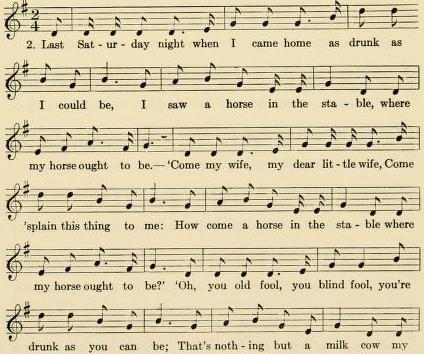
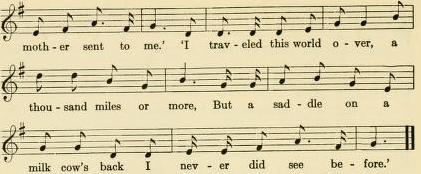
For melodic relationship cf. ***ASb 312, 'The Roving Gambler,' measures 1-4; FSF 317, No. 170, measures 3-4 and recurrences. Scale: Hexatonic (4), plagal. Tonal Center: g. Structure: aaia2a3 (8,8,8,8).
B(2) 'Arrow Goodman.' Sung by Otis Kuykendall. Recorded at Asheville, July 18, 1939. Another title given: 'Our Goodman.'
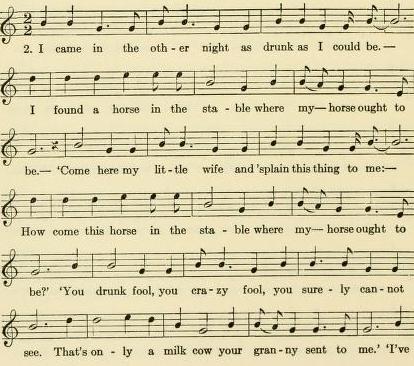

For melodic relationship cf. ***BMFSB 14, measures 1-2. Scale: Mode III, plagal. Tonal Center: g. Structure aa1a1a1 (8,8,8,8).
B(3) 'Arrow Goodman.' Sung by Miss Millie Saunders. Recorded at Jonas Ridge (Rip Shin Ridge), Burke county, June 30, 1940. Other title given: 'Our Goodman.'
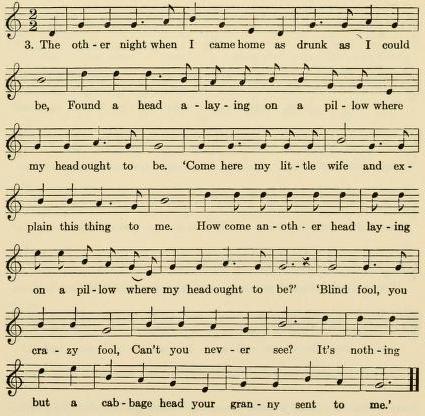
For melodic relationship cf. ***SharpK i 270, No. 38E, measures 7-8 and 15-16, and our 3-4. Scale: Mode III, plagal. Tonal Center: g. Structure: aa^a^a^ (8,8,8,8).
B(4) 'Arrow Goodman.' Sung by Miss Pearle Webb. Recorded at Pineola, Avery county, August 24, 1939. Another title given: 'Our Goodman.'
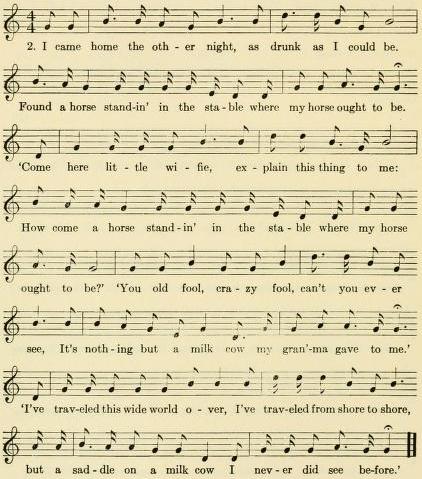
For melodic relationship cf. ***FSF 317, No. 170, measure 2 and its repetitions. Scale: Mode III, plagal. Tonal Center: g. Structure: aa1a1a1 (8,8,8,8).
B(5) 'Arrow Goodman.' Sung by Miss Pearle Webb. From a previous recording of Dr. W. A. Abrams at Boone, Watauga county, August 8, 1940. This second recording does not greatly differ from her earlier version. The variations are such as one would certainly expect.
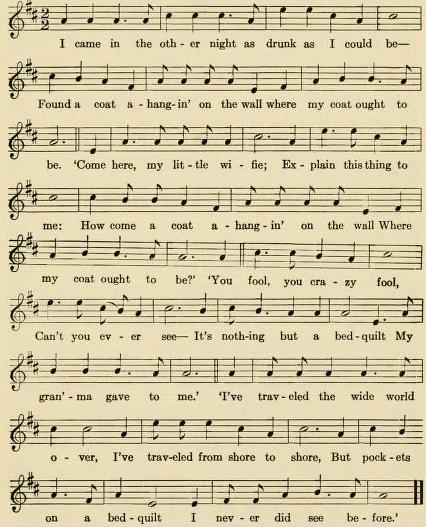
For melodic relationship cf. ***FSF 317, No. 170, measure 2 and its repetitions. Scale: Mode III, plagal. Tonal Center: a. Structure: aa1a2a2 (8,8,8,8).
B(6) 'Arrow Goodman.' Sung by Mrs. Ewart Wilson. Recorded at Pensacola, Yancey county, September, 1929. Another title given: 'Our Goodman.'
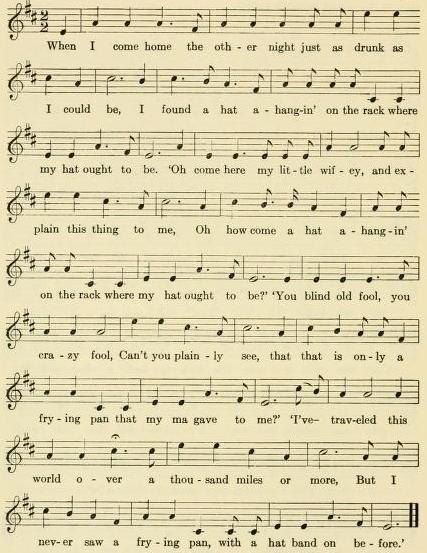
For melodic relationship cf. ***FSF 317, No. 170, measures 3-4 and their repetitions. Scale: Mode III, plagal. Tonal Center: a. Structure: aa1a2a2 (8,8,8,8). Circular Tune (V).
C. 'Our Goodman.' Sung by Frank Proffitt. No date or place given.

For melodic relationship of. **SharpK i 270, No. 38E, measures 7-8 and 15-16. Scale: Heptachordal, plagal. Tonal Center: f. Structure: aa^a^a^ (8,8,8,8).